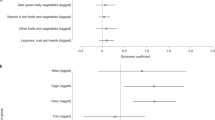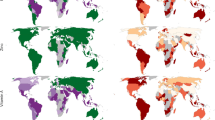Abstract
In Ethiopia, children and adults face a double burden of malnutrition, with undernutrition and stunting coexisting with non-communicable diseases. Here we use a framework of comparative risk assessment, local dietary surveys and relative risks from large observational studies to quantify the health and environmental impacts of meeting adult and child recommended daily protein intakes in urban Addis Ababa. We find that plant-based foods, especially legumes, would have the lowest environmental impact and substantially increase life expectancy in adults, while animal-source proteins could be beneficial for children. This context-specific approach—accounting for regional constraints and trade-offs—could aid policymakers in developing culturally appropriate, nutritionally adequate and sustainable dietary recommendations.
This is a preview of subscription content, access via your institution
Access options
Access Nature and 54 other Nature Portfolio journals
Get Nature+, our best-value online-access subscription
$29.99 / 30 days
cancel any time
Subscribe to this journal
Receive 12 digital issues and online access to articles
$119.00 per year
only $9.92 per issue
Buy this article
- Purchase on Springer Link
- Instant access to full article PDF
Prices may be subject to local taxes which are calculated during checkout



Similar content being viewed by others
Data availability
The datasets generated during and/or analysed during the current study are not publicly available due to limits on the data-sharing agreement by partners in Ethiopia, in compliance with institutional regulations. The data are available on reasonable request.
Code availability
All computer code used to generate results that are reported in the paper and central to its main claims is available upon request, to editors and reviewers.
References
Popkin, B. M., Corvalan, C. & Grummer-Strawn, L. M. Dynamics of the double burden of malnutrition and the changing nutrition reality. Lancet 395, 65–74 (2020).
Misganaw, A. et al. National disability-adjusted life years (DALYs) for 257 diseases and injuries in Ethiopia, 1990–2015: findings from the global burden of disease study 2015. Popul. Health Metr. 15, 28 (2017).
Ethiopia National Food Consumption Survey (Ethiopian Public Health Institute, 2013).
Krasevec, J., An, X., Kumapley, R., Bégin, F. & Frongillo, E. A. Diet quality and risk of stunting among infants and young children in low‐ and middle‐income countries. Matern. Child Nutr. 13, e12430 (2017).
Song, M. et al. Association of animal and plant protein intake with all-cause and cause-specific mortality. JAMA Intern. Med. 176, 1453–1463 (2016).
Zheng, Y. et al. Association of changes in red meat consumption with total and cause specific mortality among US women and men: two prospective cohort studies. BMJ 365, l2110 (2019).
Melse-Boonstra, A. Bioavailability of micronutrients from nutrient-dense whole foods: zooming in on dairy, vegetables, and fruits. Frontiers Nutrition 7, 101 (2020).
Headey, D., Hirvonen, K. & Hoddinott, J. Animal sourced foods and child stunting. Am. J. Agric. Econ. 100, 1302–1319 (2018).
Willett, W. et al. Food in the Anthropocene: the EAT–Lancet Commission on healthy diets from sustainable food systems. Lancet 393, 447–492 (2019).
Steinfeld, H. et al. Livestock’s Long Shadow: Environmental Issues and Options (Food & Agriculture Organization, 2006).
Whitmee, S. et al. Safeguarding human health in the Anthropocene epoch: report of the Rockefeller Foundation–Lancet Commission on planetary health. Lancet 386, 1973–2028 (2015).
Alexandratos, N. & Bruinsma, J. World Agriculture Towards 2030/2050: The 2012 Revision. ESA Working Paper 12-03 (Food & Agriculture Organization, 2012).
Abegaz, G. A. H., Ibrahim, W. & Minten, B. Consumption of Animal-source Foods in Ethiopia: Patterns, Changes, and Determinants. ESSP Working Paper 113 (International Food Policy Research Institute and Ethiopian Development Research Institute, 2018).
Springmann, M. et al. Health and nutritional aspects of sustainable diet strategies and their association with environmental impacts: a global modelling analysis with country-level detail. Lancet Planet. Health 2, e451–e461 (2018).
Springmann, M. et al. Options for keeping the food system within environmental limits. Nature 562, 519–525 (2018).
Kim, B. F. et al. Country-specific dietary shifts to mitigate climate and water crises. Glob. Environ. Change 62 (2020) https://doi.org/10.1016/j.gloenvcha.2019.05.010
Aleksandrowicz, L. et al. Environmental impacts of dietary shifts in India: a modelling study using nationally-representative data. Environ. Int. 126, 207–215 (2019).
Institute of Medicine Dietary Reference Intakes for Energy, Carbohydrate, Fiber, Fat, Fatty Acids, Cholesterol, Protein, and Amino Acids (National Academies Press, 2005).
Preston, S. H. & Stokes, A. Contribution of obesity to international differences in life expectancy. Am. J. Pub. Health 101, 2137–2143 (2011).
Milner, J. et al. Projected health effects of realistic dietary changes to address freshwater constraints in India: a modelling study. Lancet Planet. Health 1, e26–e32 (2017).
Damerau, K. et al. India has natural resource capacity to achieve nutrition security, reduce health risks and improve environmental sustainability. Nat. Food 1, 631–639 (2020).
Kinley, R. D., Kinley, R. D., Fredeen, A. H. & Fredeen, A. H. In vitro evaluation of feeding North Atlantic stormtoss seaweeds on ruminal digestion. J. Appl. Phycol. 27, 2387–2393 (2015).
Agegnehu, G., Ghizaw, A. & Sinebo, W. Yield potential and land-use efficiency of wheat and faba bean mixed intercropping. Agron. Sustain. Dev. 28, 257–263 (2008).
Rimhanen, K., Ketoja, E., Yli-Halla, M. & Kahiluoto, H. Ethiopian agriculture has greater potential for carbon sequestration than previously estimated. Glob. Change Biol. 22, 3739–3749 (2016).
Belay, S. A. et al. Conservation agriculture saves irrigation water in the dry monsoon phase in the Ethiopian highlands. Water 11, 2103 (2019).
Lalampaa, P. K., Wasonga, O. V., Rubenstein, D. I. & Njoka, J. T. Effects of holistic grazing management on milk production, weight gain, and visitation to grazing areas by livestock and wildlife in Laikipia County, Kenya. Ecol. Process. 5, 1–12 (2016).
Bakshi, M. P. S., Wadhwa, M. & Makkar, H. P. S. Waste to worth: vegetable wastes as animal feed. CAB Rev. 11, 1–26 (2016).
Mehrabi, Z., Gill, M., Wijk, M. V., Herrero, M. & Ramankutty, N. Livestock policy for sustainable development. Nat. Food 1, 160–165 (2020).
Hirvonen, K., Bai, Y., Headey, D. & Masters, W. A. Affordability of the EAT–Lancet reference diet: a global analysis. Lancet Glob. Health 8, e59–e66 (2020).
Herforth, A. et al. Cost and Affordability of Healthy Diets Across and Within Countries. FAO Agricultural Development Economics Technical Study No. 9 (Food & Agriculture Organization, 2020).
Freedman, L. S. et al. Evaluation of the 24-hour recall as a reference instrument for calibrating other self-report instruments in nutritional cohort studies: evidence from the validation studies pooling project. Am. J. Epidemiol. 186, 73–82 (2017).
Zack, R. M. et al. Validity of an FFQ to measure nutrient and food intakes in Tanzania. Pub. Health Nutr. 21, 2211–2220 (2018).
Ethiopian Health and Nutrition Research Institute Food Composition Table for Use in Ethiopia (EHNRI, 1998).
Lukmanji, Z. et al. Tanzania Food Composition Tables. (Muhimbili University of Health and Allied Sciences, Tanzania Food and Nutrition Centre and Harvard School of Public Health, 2008).
Olofin, I. et al. Associations of suboptimal growth with all-cause and cause-specific mortality in children under five years: a pooled analysis of ten prospective studies. PLoS One 8, e64636 (2013).
World Population Prospects 2019 (United Nations Department of Economic and Social Affairs Population Division, 2019).
United Nations Inter-agency Group for Child Mortality Estimation. Levels & Trends in Child Mortality Report 2018. (UN-IGME, 2018); https://www.unicef.org/media/47626/file/UN-IGME-Child-Mortality-Report-2018.pdf
The 2007 Population and Housing Census of Ethiopia (Federal Democratic Republic of Ethiopia Population Census Commission Central Statistical Agency, 2010).
Mekonnen, M. & Hoekstra, A. Y. National Water Footprint Accounts: The Green, Blue and Grey Water Footprint of Production and Consumption. Volume 1, Main Report. (UNESCO-IHE, 2011).
Hillier, J. et al. A farm-focused calculator for emissions from crop and livestock production. Environ. Modell. Softw. 26, 1070–1078 (2011).
Report on Area and Production of Major Crops. Statistical Bulletin No. 586 (Federal Democratic Republic of Ethiopia Central Statistical Agency, 2018).
Herrero, M. et al. Biomass use, production, feed efficiencies, and greenhouse gas emissions from global livestock systems. Proc. Natl Acad. Sci. USA 110, 20888–93 (2013).
FAO Statistical Database, http://www.fao.org/faostat/en/#home (Food & Agriculture Organization, 2016).
Mengistu, A., Kebede, G., Feyissa, F. & Assefa, G. Review on major feed resources in Ethiopia: conditions, challenges and opportunities. Acad. Res. J. Agric. Sci. Res. 5, 176–185 (2017).
Ethiopian Public Health Institute Ethiopia National Food Consumption Survey. (Ethiopian Public Health Institute, 2013).
Acknowledgements
We thank M. Herrero and C. Godde for providing detailed livestock data for Ethiopia. This work was supported by the Economic and Social Research Council (ES/R002118/1).
Author information
Authors and Affiliations
Contributions
M.M.B., G.D., A.L.B., C.R.C., S.S.M. and W.W.F. designed the research study. A.W.T., Y.B. and W.W.F. conducted field research and oversaw implementation. M.M.B., G.D., R.Z. and K.D. analysed the data. M.M.B. wrote the paper. M.M.B. and W.W.F. have primary responsibility for final content. A.L.B. conducted the literature review. L.B. and S.S.M. critically revised the manuscript for important intellectual content. All authors read and approved the final manuscript and are accountable for all aspects of the work.
Corresponding author
Ethics declarations
Competing interests
The authors declare no competing interests. The funder of the study had no role in study design, data collection, data analysis, data interpretation or writing of the report. All authors had full access to all the data in the study and the corresponding author had final responsibility for the decision to submit for publication.
Additional information
Peer review information Nature Food thanks Baye Kaleab, Jules Siedenburg and Roseline Remans for their contribution to the peer review of this work.
Publisher’s note Springer Nature remains neutral with regard to jurisdictional claims in published maps and institutional affiliations.
Supplementary information
Supplementary Information
Supplementary text, tables and figure.
Rights and permissions
About this article
Cite this article
Blakstad, M.M., Danaei, G., Tadesse, A.W. et al. Life expectancy and agricultural environmental impacts in Addis Ababa can be improved through optimized plant and animal protein consumption. Nat Food 2, 291–298 (2021). https://doi.org/10.1038/s43016-021-00264-2
Received:
Accepted:
Published:
Issue Date:
DOI: https://doi.org/10.1038/s43016-021-00264-2



